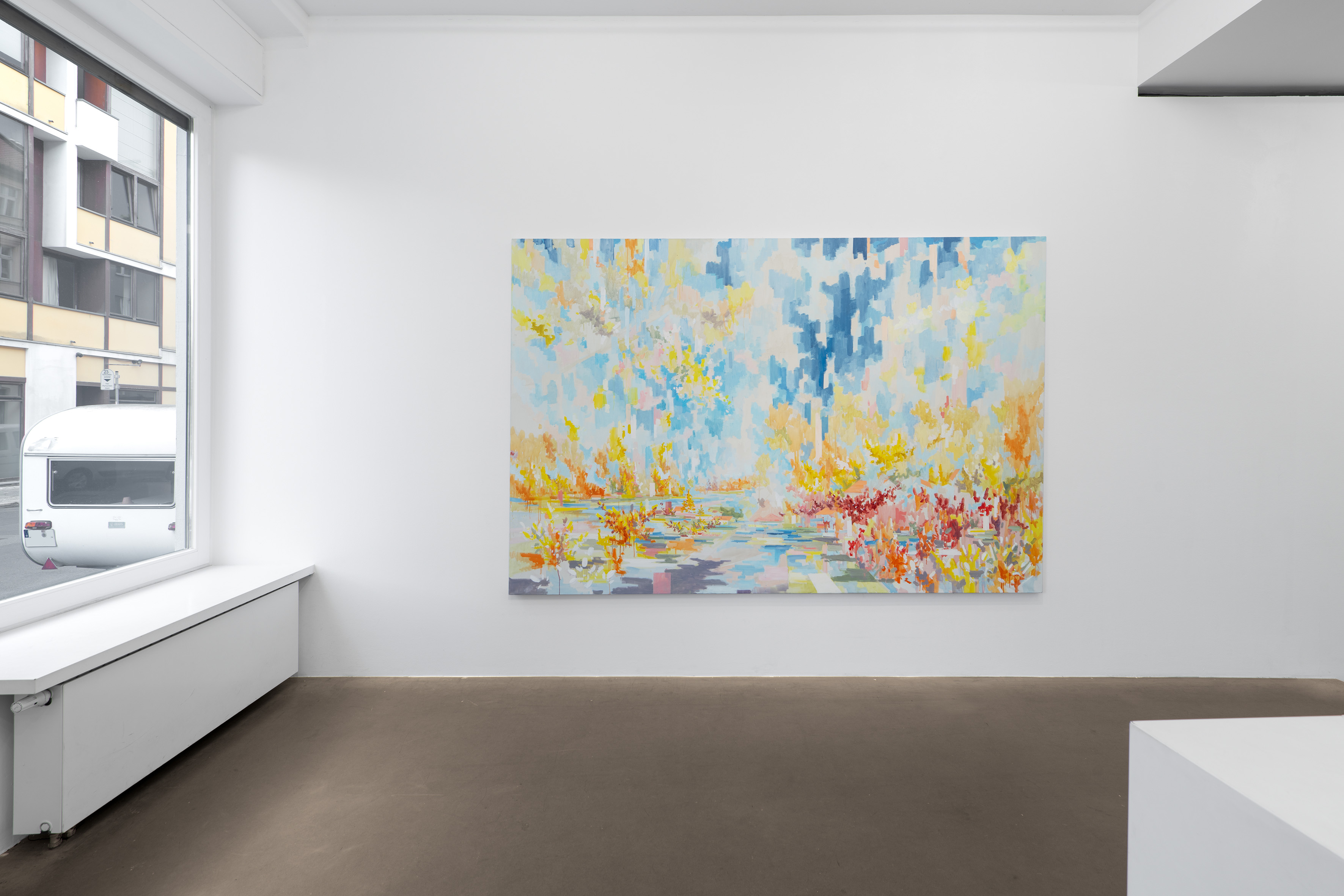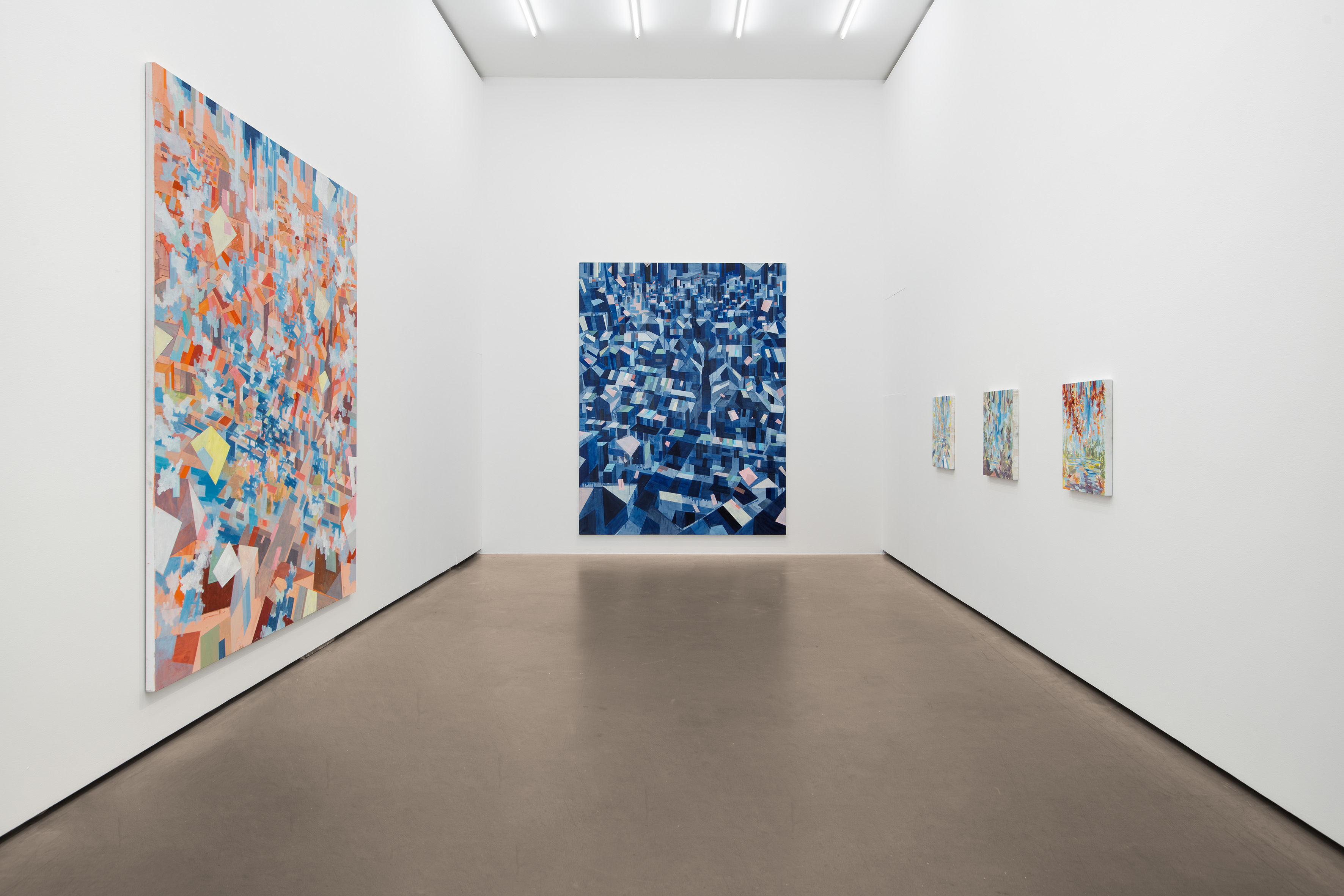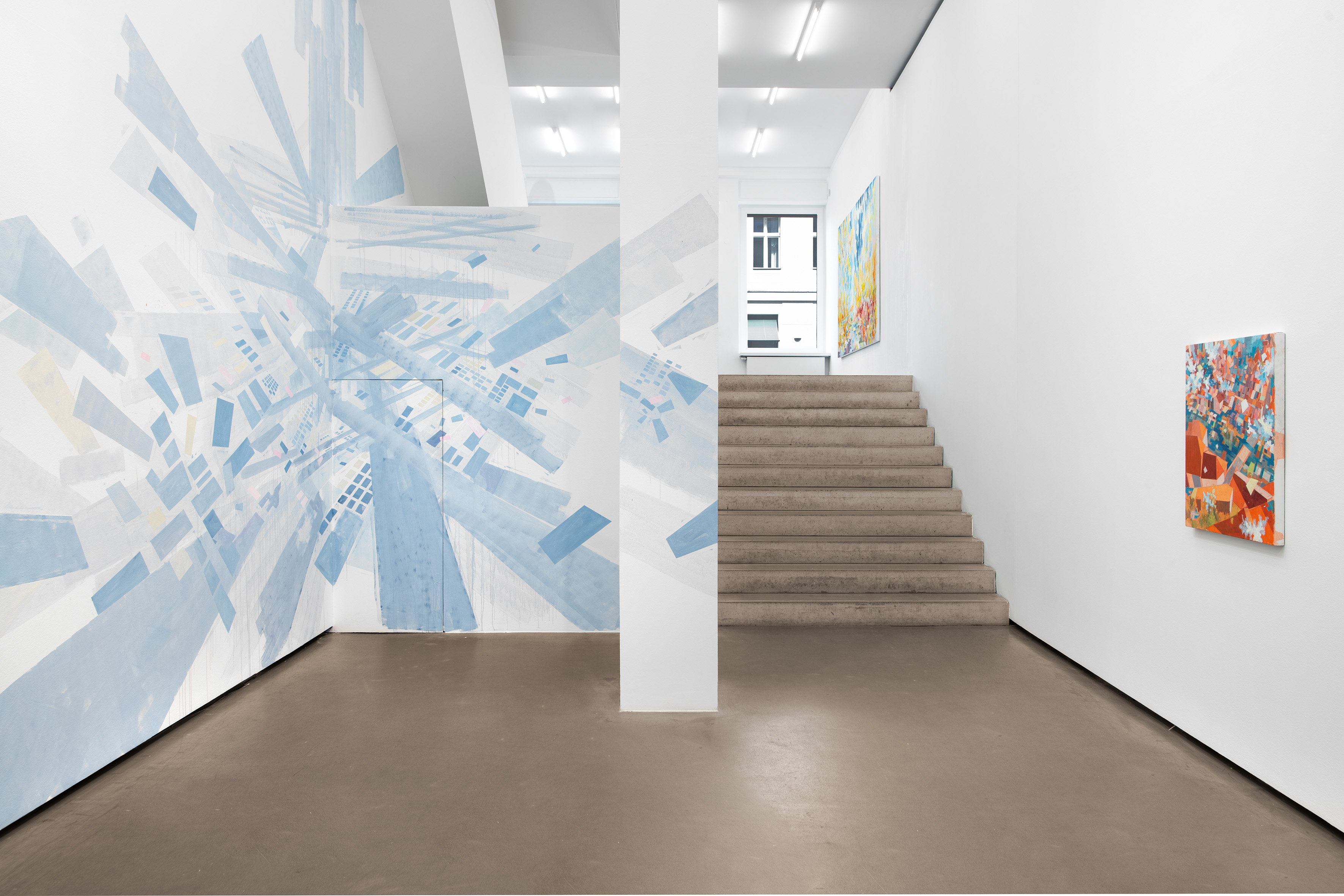David Schnell
Flyer
August 31 – October 21, 2023
Galerie EIGEN + ART Berlin

“On that day, man shall go out from Egypt.”1
When I was shown David Schnell’s new works in advance in his studio, this dictum of the Koschnitz teacher came to mind. But this time it came to me wordlessly. It snaked through me, between the allochromatic components and formations that rise in the pictorial spaces, sometimes cloudy, sometimes geometrical and fragmented, and that sink down from unknown, heavenly weathers. But what does this demand have to do with the cities and regions that we believe we find depicted here and that plainly have nothing to do with Egypt? Viewed architectonically, we would like to recognize something European, and Europe is where David Schnell evidently took his motifs, whether from the North or the South of the continent, from urban agglomerations or from rural locations. At any rate, the temptation to place them geographically can’t be as easily shaken as they are quite useless on the whole. Useless when it turns out that no wall stands firmly on another, roofs no longer rest on load-bearing constructions, no bush finds a hold in the soil, and this pretty ground itself has lost all solid depth below it. The fixed firmaments, too, are separated, etched away by chemical reactions that are visible only in the painted transfer, penetrated by craggy steles, the droning organs of time. Even if David Schnell would reveal to us where he gets his models, where he sketched or photographed them, what results from them, what the artist has reproduced, remaining as much figure, sign, and metaphor as is the reference to the Exodus from Egypt. Where are we located when we gaze into these pictorial works. Still in history? In a memory? In a terrain that still lies before us? As if revealed by all metallographic methods or infrared cameras, what is otherwise hidden from our eyes and at the same time occurs in the world’s spaces that we appropriate and inhabit us seems to me so wonderfully painterly processed.

When the famous Exodus from Egypt took place, from the country that was rich, highly civilized, and scientifically in best form, suddenly the dwellings stood as abandoned and the doors as open, the alleys as quiet, and the riverbanks, elevations, and the edges of fields as void of human presence as in David Schnell’s pictures. The question of parallel events and pictures that cannot be pulled from the fixative bath of substantiated history besets me almost every time that I find myself on David Schnell’s pictorial stages. The Exodus from Egypt that I adduce here is treated in the Hebrew Bible as a historical event, but serious historians do not regard it as certain. To this day, no dependable archaeological evidence and no confirming Egyptian sources have been found (and the Egyptians documented everything). But I regard some of David Schnell’s pictures as such a recording, but just like the figure of memory that the Exodus is, without concrete historical markers. “Egypt” means more than the North African country. It is an intellectual metaphor. Its meaning is: mammon, the ebullient fullness of the material world, the golden desert of the demon that fixates us with worldly pomp and by chaining us to it. A lush place of fleshpots and palaces, all splendidly appointed, with elegant furniture, painted walls, polished basalt, and mystical machines. The temples are clear stone, the streets and buildings like crystal, glittering odes of self-certainty. A sated civilization. The long ignominy of human weakness finally lies behind us. Et in Aegyptia ego.
But those who depart, withdraw, disappear into another, promised and yearned for new land, out of the slavery that made this world empire great in the first place, these apostates open the view onto the emptiness of this empire. They create the figure of memory, prepare an eternal memory that sets up the distance from and distance to interior worldly diffidence. Is there a new land? Perhaps a land of the mind? Where is it? David Schnell’s pictures give me no answers. They seem to me more like an expression of the question. A question about the fragile place, about the moment of breaking and breaking off. One cannot leave the world itself. But it can become transparent. “There is a crack in everything. That’s how the light gets in.“2 The light in David Schnell’s pictures presses from everywhere through the backdrops.
But from this desert of earthliness, the path goes into a new desert, because beyond security, beyond the empire, there is initially nothing but hot sand and this glaring light! The old world, filled to the brim, suddenly becomes empty and insipid. Viewed from the high scarp ensconcing the Nile Valley, the Egyptian Empire appears as a huge sarcophagus (Greek sarkophágos: flesh eater). One creates distance for oneself and looks out over or down upon the world. Once out of Egypt, departed from the clinging servitude of matter, one is no longer completely stuck in it. But a precarious question belongs to this: Where should the journey actually go? To the promised land?
It is and remains the promise of differentiation, the necessary movement to maintain the ability to perceive and understand. That’s why the departure is the true image of (or in) the false. I think it would be more than regrettable – yes, even tragic – if historical evidence for the “Exodus from Egypt” was actually found after all. The metaphor could weaken to the point that we lost the decisive image of difference. If this figure of thought did not exist, we might be eternally mummified in Egypt. One must create this figure, relate it, think it, paint it, in order to avoid sticking to history’s layers of color. Thus, the question of where one should go, nothing less, is put to us also by art, is given to me to see and ponder by David Schnell’s pictures.

The perspectives in David Schnell’s pictures have changed: What the gaze once saw before it, the strict pull from all edges of the space into the middle of the radiant world, a view from the central eye of the observer, is now replaced by an overview down from above. From the tower, from the apex of the pyramid, from an inexorable camera circling in the sky? An observation absolved from the human point of view, as taken by machines. It is the view of the angel of history. And before this eye, the deserted places are transformed – here, we ourselves adopt this non-human view – into states of things that no longer obey the basic truths of space and time. The structure bares itself. Components join it, lose their solidity, transform themselves. And the more our eyes approach the surfaces of the painted canvas, the more what we had just perceived as geometrically organized eludes us. We find ourselves in lucid abysses and floating shafts from which even the earth’s gravity has departed. What is architectonically determined no longer complies, it dwindles or deepens itself in willfully extended passages and chambers driven deep into the space that hide their functions from us and behave in the state of abandonment like rampantly proliferating crystals. Reflecting surfaces form from spaceless slabs. They flake off as glowing components from cubic volumes, rise and float toward an original state or end bang of which no one who departed knew anything. The connections of inner-worldly order are burst. An interfering, loosened matter released from human hands and gravity. We see that, in David Schnell’s painting, “the immediate reality of things dissolves and their components are used to actualize [painterly] goals – without regard for whatever inviolabilities that resulted from the earlier image of man and nature.” 3
And just as the urban constructions, the large interior spaces and sacred halls shed their identity, so, too, they detach themselves from the strictness of style engrained in them. Another Exodus: The departure of space from the canon of form. The exfoliation from the concept of construction reaches stages of transformation that elude discipline, as did the form language of architecture on the way to modernism and its dissolution. Settlements unsettle themselves; landscapes move themselves away. Morphology turns into a chemically shivering state that is still recognizable in its initial construction, but new orders tower up: A new world? A promised land? Or only the evaporation and decomposition of the old, inhabitable earth? The toxic colors that clash in the iridescent light of silent river valleys, the rising and sinking beats of the sounding tourmalines; they turn every wish to turn back again into a nightmare – even though carpets, blankets, hand towels, and curtains were just brought out of the rooms to dry (?). They lie there as colorful thoughts, perhaps even as memories of last tendernesses, still here and there on the roofs. As if they, signals of the living and of a humorously reversed superstition, were quickly left there – for a divine eye?

Now our dreams of the world fray, jangle, and dilate – our dreams in which we copiously amuse ourselves, or patiently endure, or out of which we constantly depart – just like the wily wisps in David Schnell’s pictures. Space – that’s how it feels to me – dismisses us, since we have already left it. The earth rejects us. New beauty, no longer described by anyone, dawns. We must now depart, without ever having wanted to. Depart, without having an inkling of the promised land? It buzzes and drones in the painted air that seems suspiciously low in oxygen to me. The house down there by the river will hardly host new summer guests; it burns, white as egg white. It burns like the house that Buddha told his students about:4 The people in the smoldering house ask and pose pseudo-questions, even when the fire is already consuming the roof timbers. They ask how it would be outside, whether things proceed happily there or if it would merely be boring, and if there is enough bath water at all in the desert. In the Nile Valley and in Berlin, water still flows. But it is so hot and dry, the islands between Berlin and Luxor burn in the sea. The pennants and kites rise up unobserved and untethered, now reflecting the moonlight. The obelisks of our thoughts teeter. Small slips of paper lie in the alleys, full of knowledge, but nothing more can be said to us – no further interpretation, no message that hadn’t already been delivered comes to us from these calm emblems of departure.
Bertram Haude, 2023
(Translation by Mitch Cohen)
1 Rabbi Israel ben Schabtai Hapstein von Koschnitz. Martin Buber, Schriften zum Chassidismus, Kösel/ Lambert-Schneider: 1963.
2 Leonard Cohen: “Anthem”, Album “The Future”, Colombia, 1992 (theme from the kabbalistic teaching of Isaak Luria).
3 Romano Guardini: Das Ende der Neuzeit, Werkbund-Verlag: 1950.
4 Bertolt Brecht: Das Gleichnis des Buddha vom brennenden Haus, Gesammelte Werke, Suhrkamp:1967.